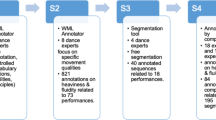Abstract
This paper presents a unified framework that evaluates dance performance by markerless estimation of human poses. Dance involves complicated poses such as full-body rotation and self-occlusion, so we first develop a human pose estimation method that is invariant to these factors. The method uses ridge data and data pruning. Then we propose a metric to quantify the similarity (i.e., timing and accuracy) between two dance sequences. To validate the proposed dance evaluation method, we conducted several experiments to evaluate pose estimation and dance performance on the benchmark dataset EVAL, SMMC-10 and a large K-Pop dance database, respectively. The proposed methods achieved pose estimation accuracy of 0.9358 mAP, average pose error of 3.88 cm, and 98% concordance with experts’ evaluation of dance performance.











Similar content being viewed by others
Notes
The K-Pop database is available from https://goo.gl/NoVDm4.
References
Alexander T, Szegedy C (2014) Deeppose: Human pose estimation via deep neural networks. In: The IEEE conference on computer vision and pattern recognition, pp 1653–1660
Baak A, Müller M, Bharaj G, Seidel H-P, Theobalt C (2011) A data-driven approach for real-time full body pose reconstruction from a depth camera. In: IEEE international conference on computer vision, pp 1092–1099
Cao Z, Simon T, Wei S, Sheikh Y (2017) Realtime multi-person 2D pose estimation using part affinity fields. In: The IEEE conference on computer vision and pattern recognition
Comaniciu D, Ramesh V, Meer P (2003) Kernel-based object tracking. IEEE Trans Pattern Anal Mach Intell 25(5):564–577
Dillencourt M, Samet H, Tamminen M (1992) A general approach to connected-component labeling for arbitrary image representations. J ACM 39(2):253–280
Ganapathi V, Plagemann C, Koller D, Thrun S (2010) Real time motion capture using a single time-of-flight camera. In: IEEE conference on computer vision and pattern recognition, pp 755–762
Ganapathi V, Plagemann C, Koller D, Thrun S (2012) Real-time human pose tracking from range data. In: European conference on computer vision, pp 738–751
Hough P (1959) Machine analysis of bubble chamber pictures. In: International conference on high energy accelerators and instrumentation, pp 73
Huang J, Altamar D (2016) Pose estimation on depth images with convolutional neural network
Jalal A, Kamal S, Kim D (2014) A depth video sensor-based life-logging human activity recognition system for elderly care in smart indoor environments. Sensors 14(7):11735–11759
Jalal A, Kamal S, Kim D (2015) Depth Silhouettes Context: A new robust feature for human tracking and activity recognition based on embedded HMMs. In: 12th international conference on ubiquitous robots and ambient intelligence, pp 294–299
Jung H, Lee S, Heo Y, Yun I (2015) Random tree walk toward instantaneous 3D human pose estimation. In: The IEEE conference on computer vision and pattern recognition, pp 2467–2474
Kim Y, Kim D (2015) Efficient body part tracking using ridge data and data pruning. In: IEEE-RAS 15th international conference on humanoid robots, pp 114–120
Lee M, Nevatia R (2009) Human pose tracking in monocular sequence using multilevel structured models. IEEE Trans Pattern Anal Mach Intell 31(1):27–38
Ofli F, Kurillo G, Obdrzalek S, Bajcsy R, Jimison H, Pavel M (2015) Design and evaluation of an interactive exercise coaching system for older adults: lessons learned. J Biom Heath Inform 20(1):201–212
Plagemann C, Ganapathi V, Koller D, Thrun S (2010) Real-time identification and localization of body parts from depth images. In: IEEE international conference on robotics and automation, pp 3108–3113
Raptis M, Kirovski D, Hoppe H (2011) Real-time classification of dance gestures from skeleton animation. In: The 2011 ACM SIGGRAPH/Eurographics symposium on computer animation 147–156
Reyes M, Dominguez G, Escalera S (2011) Featureweighting in dynamic timewarping for gesture recognition in depth data. In: IEEE international conference on computer vision workshops, pp 1182–1188
Schramm R, Jung C, Miranda E (2015) Dynamic time warping for music conducting gestures evaluation. IEEE Trans Multimedia 17(2):243–255
Shotton J, Girshick R, Fitzgibbon A, Sharp T, Cook M, Finocchio M, Moore R, Kohli P, Criminisi A, Kipman A, Blake A (2013) Efficient human pose estimation from single depth images. IEEE Trans Pattern Anal Mach Intell 35 (12):2821–2840
Sung J, Ponce C, Selman B, Saxena A (2011) Human Activity Detection from RGBD Images, plan, activity, and intent recognition, vol 64
Xia L, Chen C, Aggarwal J (2012) View invariant human action recognition using histograms of 3d joints. In: IEEE computer society conference on computer vision and pattern recognition workshops, pp 20–27
Yang X, Tian Y (2014) Effective 3d action recognition using eigenjoints. J Vis Commun Image Represent 25(1):2–11
Ye M, Yang R (2014) Real-time simultaneous pose and shape estimation for articulated objects using a single depth camera. In: IEEE conference on computer vision and pattern recognition, pp 2345–2352
Yun K, Honorio J, Chattopadhyay D, Berg T, Samaras D (2012) Two-person interaction detection using body-pose features and multiple instance learning. In: IEEE computer society conference on computer vision and pattern recognition workshops, pp 28–35
Acknowledgments
This research was partially supported by the MSIT (Ministry of Science, ICT), Korea, under the SW Starlab support program (IITP-2017-0-00897) supervised by the IITP (Institute for Information & communications Technology Promotion).
This work was partially supported by Institute for Information & communications Technology Promotion (IITP) grant funded by the Korea government (MSIT) (IITP-2014-0-00059, Development of Predictive Visual Intelligence Technology).
Author information
Authors and Affiliations
Corresponding author
Electronic supplementary material
Below is the link to the electronic supplementary material.
Rights and permissions
About this article
Cite this article
Kim, Y., Kim, D. Real-time dance evaluation by markerless human pose estimation. Multimed Tools Appl 77, 31199–31220 (2018). https://doi.org/10.1007/s11042-018-6068-4
Received:
Revised:
Accepted:
Published:
Issue Date:
DOI: https://doi.org/10.1007/s11042-018-6068-4




